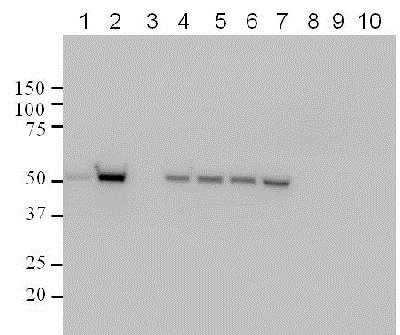Anti-p53 (phospho S15) antibody (ab1431)
Key features and details
- Rabbit polyclonal to p53 (phospho S15)
- Suitable for: ICC, WB
- Reacts with: Rat, Human
- Isotype: IgG
Overview
-
Product name
Anti-p53 (phospho S15) antibody
See all p53 primary antibodies -
Description
Rabbit polyclonal to p53 (phospho S15) -
Host species
Rabbit -
Tested applications
Suitable for: ICC, WBmore details -
Species reactivity
Reacts with: Rat, Human -
Immunogen
Synthetic peptide corresponding to Human p53 (intracellular) (phospho S15).
Database link: P04637-1 -
General notes
The Life Science industry has been in the grips of a reproducibility crisis for a number of years. Abcam is leading the way in addressing this with our range of recombinant monoclonal antibodies and knockout edited cell lines for gold-standard validation. Please check that this product meets your needs before purchasing.
If you have any questions, special requirements or concerns, please send us an inquiry and/or contact our Support team ahead of purchase. Recommended alternatives for this product can be found below, along with publications, customer reviews and Q&As
Properties
-
Form
Liquid -
Storage instructions
Shipped at 4°C. Store at +4°C short term (1-2 weeks). Upon delivery aliquot. Store at -20°C. Avoid freeze / thaw cycle. -
Storage buffer
Preservative: 0.01% Sodium azide
Constituents: 30% Glycerol (glycerin, glycerine), 0.42% Potassium phosphate, 0.87% Sodium chloride -
 Concentration information loading...
Concentration information loading... -
Purity
Affinity purified -
Clonality
Polyclonal -
Isotype
IgG -
Research areas
Images
-
All lanes : Anti-p53 (phospho S15) antibody (ab1431) at 1 µg/ml
Lane 1 : HEK-293T (Human epithelial cell line from embryonic kidney transformed with large T antigen) cells at 20 µg
Lane 2 : HEK-293T cells incubated with etoposide at 20 µg
Lane 3 : MCF7 (Human breast adenocarcinoma cell line) cells at 20 µg
Lane 4 : MCF7 cells incubated 6 hours with camptothecin at 20 µg
Lane 5 : MCF7 cells incubated 16 hours with camptothecin at 20 µg
Lane 6 : MCF7 cells incubated 24 hours with camptothecin at 20 µg
Lane 7 : HEK-293T incubated with etoposide at 7.5 µg
Lane 8 : Lambda phosphatase (400 times-diluted)-treated extract of HEK-293T incubated with etoposide at 7.5 µg
Lane 9 : Lambda phosphatase (100 times-diluted)-treated extract of HEK-293T incubated with etoposide at 7.5 µg
Lane 10 : Lambda phosphatase (25 times-diluted)-treated extract of HEK-293T incubated with etoposide at 7.5 µg
Secondary
All lanes : Goat anti rabbit IgG(H&L)-HRP at 1/10000 dilution
Developed using the ECL technique.
Performed under reducing conditions.
Predicted band size: 53 kDa
Observed band size: 53 kDa
Exposure time: 2 minutesSDS PAGE performed under reducing conditions (100mM DTT, Sample heated at 50°C).
Blocking: 5% Milk + PBS for 3 hours at RT.Primary antibody: 5% BSA + PBS overnight at 4 C.
Secondary antibody: 5% Milk + PBS for 2 hour at RT.
-
 Immunocytochemistry - Anti-p53 (phospho S15) antibody (ab1431) This image is a courtesy of Anonymous Abreview
Immunocytochemistry - Anti-p53 (phospho S15) antibody (ab1431) This image is a courtesy of Anonymous Abreviewab1431 staining p53 in rat bone marrow cells by Immunocytochemistry/ Immunofluorescence.
The cells were fixed in paraformaldehyde, permeabilized in 0.1% Triton X-100 and then blocked using 5% BSA for 1 hour at 25°C. Samples were then incubated with primary antibody at 1:100 for 9 hours at 4°C. The secondary antibody used was a goat anti-rabbit Alexa Fluor® 488 (green) ab150077) used at a 1/250 dilution. DAPI was used to stain the cell nuclei (blue).
These pictures were taken in the different fields of the same bone marrow cell slide.
-
Immunocytochemistry analysis of PC12 cells labeling p53 (phospho S15) with ab1431.
-
 Immunocytochemistry - Anti-p53 (phospho S15) antibody (ab1431) Image courtesy of an anonymous Abreview
Immunocytochemistry - Anti-p53 (phospho S15) antibody (ab1431) Image courtesy of an anonymous Abreviewab1431 staining p53 in mouse bone marrow WBCs cells by ICC/IF (Immunocytochemistry/immunofluorescence).
Cells were fixed with formaldehyde, permeabilized with 0.1% Triton X-100 and blocked with 5% serum for 2 hours at 25°C. Samples were incubated with primary antibody (1/100 in PBS) for 12 hours at 4°C. An Alexa Fluor® 488-conjugated Goat anti-rabbit IgG polyclonal (1/500) was used as the secondary antibody.




















